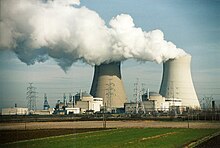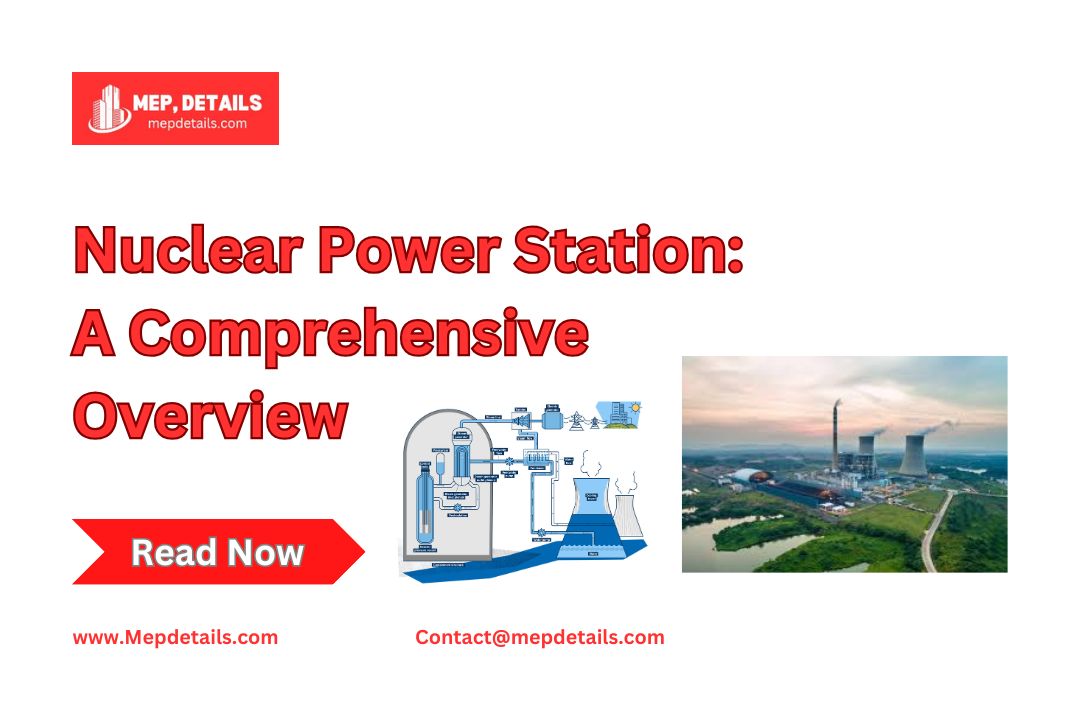A nuclear power station (NPS), also called a nuclear power plant (NPP), generates electricity using heat from a nuclear reactor. Like other thermal power stations, it produces steam that drives a turbine connected to a generator. As of September 2023, the International Atomic Energy Agency reported 410 operating nuclear reactors in 32 countries, with 57 more under construction. In this article, we will explore nuclear fission, its basic components, and the advantages and disadvantages of nuclear power.
What is Nuclear Fission?

Nuclear fission is the process where the nuclei of heavy radioactive atoms split into two nearly equal parts. When these nuclei break apart, they release a large amount of energy. This energy release happens because of a mass defect, meaning that the total mass of the resulting products is less than the mass of the original atoms. This lost mass turns into heat energy, following Albert Einstein’s famous equation.
A nuclear power station works similarly to a regular thermal power station. The main difference is that instead of burning coal to produce heat, a nuclear power plant uses heat from nuclear fission to turn water into steam in the boiler. This steam drives a steam turbine.
The turbine is connected to an alternator, which generates electrical energy. While nuclear fuel is not very abundant, a small amount of it can produce a massive amount of electricity. This is a unique feature of nuclear power plants. For example, one kilogram of uranium can create as much energy as 4,500 metric tons of high-grade coal. This means that the complete fission of 1 kg of uranium can generate the same amount of heat as burning 4,500 metric tons of high-grade coal.
Basic Components of a Nuclear Power Station
- Fuel handling
- Radwaste system
- Refueling floor
- Spent fuel pool
- Online refueling machines (found in designs like RBMK and CANDU)
- Power generation
- Condenser
- Cooling tower
- Electrical generator
- Steam turbine
- Reactor assembly
- Control rod drives
- Instrumentation (e.g., ion chambers)
- Control rods
- Coolant
- Neutron howitzer
- Neutron moderator
- Neutron poison
- Nuclear fuel
- Nuclear reactor core
- Reactor pressure vessel (most reactors)
- Startup neutron source
- Safety systems
- Containment building
- Emergency core cooling system
- Emergency power system
- Essential service water system
- Reactor protection system
- Standby liquid control system
- Steam generation
- Boiler feedwater pump
- Steam generators (used in PWR reactors with pressurizers)
Advantages of Nuclear Power Station
- Nuclear power stations use less fuel, which lowers electricity generation costs compared to other methods. They require a smaller space than conventional power stations with the same capacity.
- These stations do not need a lot of water, so they don’t have to be built near natural water sources. They also don’t need to be close to coal mines or good transport facilities, allowing them to be set up near where electricity is used.
- With plenty of nuclear fuel available worldwide, these plants can provide a steady supply of electricity for thousands of years.
Disadvantages of Nuclear Power Plant
- Fuel for nuclear plants is hard to find and very expensive.
- Building a nuclear power station costs a lot of money.
- Setting up and starting this plant is more complex than for regular power stations.
- The by-products of nuclear reactions are radioactive and can cause serious pollution.
- Maintenance costs are high, and the plant needs many trained specialists to operate.
- Nuclear plants struggle to handle sudden changes in energy demand.
- Disposing of radioactive by-products is a major challenge; they must be buried deep underground or placed far out at sea.
Conclusion
Nuclear power stations play a crucial role in generating electricity efficiently and with lower fuel costs compared to traditional power plants. They harness the power of nuclear fission to produce vast amounts of energy from small amounts of fuel. While these plants offer significant advantages, such as reduced space requirements and a steady energy supply, they also face challenges like high construction costs, complex operations, and the safe disposal of radioactive waste. As we explore future energy solutions, nuclear power remains a vital option that requires careful consideration of its benefits and drawbacks.
FAQs
What is the nuclear power station?
A nuclear power station uses nuclear reactors to control fission reactions, producing heat that creates steam to turn turbines and generate electricity.
What are the 4 major nuclear power stations in India?
The four major nuclear power stations in India are Tarapur (1400 MW), Rawatbhata (1180 MW), Narora (440 MW), and Kakrapar (440 MW).
What is the definition of nuclear power?
Nuclear power is the electricity generated by power plants that produce heat through fission in a nuclear reactor.
What is the purpose of a nuclear power plant?
A nuclear power plant generates electricity by using nuclear fission in reactors, which heat water to create steam that spins a turbine and generator.
Read More – Hydropower Plants: Definition, Working Principle, Types













